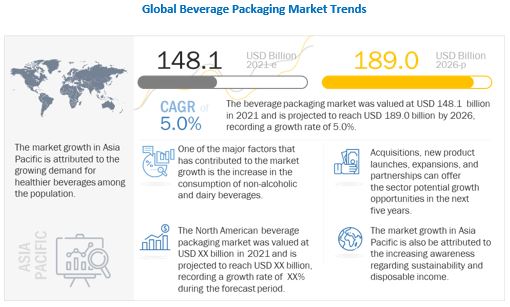The global beverage packaging market is valued at USD 148.1 billion in 2021 and is projected to reach nearly USD 189.0 billion by 2026, growing at a CAGR of 5.0%. The key drivers of the market are the rise in consumption of alcoholic beverages in emerging economies of Asia Pacific; dairy beverages worldwide. The population and income are growing in tandem with the increasing health and hygiene concerns. The urban population is increasing with the rising employability in urban areas, which, in turn, is leading to the changing lifestyle and adoption of on-the-go consumption.
Download PDF brochure: https://www.marketsandmarkets.com/pdfdownloadNew.asp?id=1222

On the basis of packaging type, the market is segmented into bottle, can, pouch, carton, and others. Bottles are suitable for packaging all kinds of beverages, including soft drinks, juices, energy drinks, and beers, and alcoholic, non-alcoholic, and dairy beverages. Packaging depends upon the type of beverage it contains. For instance, alcohols are served in glass bottles and carbonated drinks in PET bottles. However, the ease of handling of PET bottles makes it suitable for all kinds of distribution channels and ensures the safety of products. This has resulted the bottle packaging type to hold the largest market share in the beverage packaging market.
Based on material type, the beverage packaging is market is divided into metal, plastic, glass, paper & paperboard, and other material types. Packaging material types provide a means to preserve, protect, merchandise, market and distribute food & beverage products. They play a significant role in providing products in a safe and wholesome form to customers without compromising quality. The metal used for beverages can be aluminum or steel. In the case of non-alcoholic beverages, both are used for packaging. The chemical compatibility of the product and packaging material type is critical to the quality of the product. Aluminum and steel are inert in terms of reactivity with non-alcoholic beverages; hence, the most suited material type for their packaging. These are a few primary reasons that has boosted the market for metal segment in beverage packaging.
The global beverage packaging market, on the basis of product type has been segmented into non-alcoholic beverage, alcoholic beverage, and dairy beverage. Non-alcoholic beverages are beverages without alcohol or those which consist of little content of alcohol. A non-alcoholic beverage usually acts as refreshment drinks for the majority of the population. Hence it captures a major market share in the overall beverage market. It can be categorized into bottled water, juices, ready-to-drink beverages, regular tea & coffee, soft drinks, and energy drinks. The non-alcoholic beverage market is flooded with a large number of strong brands of all product categories that make the market highly competitive. All these factors have contributed the non-alcoholic beverage segment to hold the largest market share.
Speak to Analyst: https://www.marketsandmarkets.com/speaktoanalystNew.asp?id=1222
The beverage packaging market in Asia Pacific is projected to hold a significant market share in the beverage packaging market. The region comprises two high-growth economies, namely, India and China. The drinking preferences of Asia Pacific population are gradually shifting toward alcoholic culture. The increase in the size of the population and the growing market has meant that the demand for non-alcoholic beverages is projected to offer promising opportunities. This has helped the market for beverage packaging to grow in Asia Pacific region.